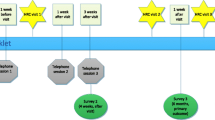Abstract
This study presents a retrospective assessment of a psychological intervention examined for its potential cost-effectiveness if implemented into standard care. It discusses (1) the cost of instituting a psychological intervention for distressed melanoma patients, (2) the effectiveness of that intervention for reducing distress when compared with a standard care group, and (3) the costs of providing the treatment as compared to costs of physician time to answer distress-driven questions as part of standard care. Although the per-minute cost of providing the psychological intervention was marginally greater than standard care, providing the intervention was significantly cheaper in terms of distress reduction. Inclusion of 60% payer reimbursement rates for the intervention further suggested that incorporating a psychological intervention into standard medical care for melanoma patients would potentially generate revenue.
Similar content being viewed by others
REFERENCES
Brouwer, W. B., & Koopmanschap, M. A. (2000). On the economic foundations of CEA. Ladies and gentlemen, take your positions! Journal of Health Economics, 19, 439–459.
Caudill, M., Schnable, R., Zuttermeister, P., Benson, H., & Friedman, R. (1991). Decreased clinic utilization by chronic pain patients after behavioral medicine intervention. Pain, 45, 334–335.
Chambless, D. L., & Hollon, S.D. (1998). Defining empirically supported therapies. Journal of Consulting and Clinical Psychology, 667–18.
Chiles, J. A., Lambert, M. J., & Hatch, A. L. (1999). The impact of psychological interventions on medical cost offset: A meta-analytic review. Clinical Psychology: Science and Practice, 6(2), 204–220.
Cummings, N.A. (1991). Arguments for the financial efficacy of psychological services in health care settings. In J. J. Sweet (Ed.), Handbook of clinical psychology in medical settings (pp. 113–126). New York: Plenum.
Cummings, N. A., & Follette, W. T. (1968). Psychiatric services and medical utilization in a prepaid health plan setting: Part 2. Medical Care, 6, 31–41.
Derogatis, L. R. (1992). The Brief Symptom Inventory (BSI) Administration, scoring and procedures manual-II. Clinical Psychometric Research, Inc., Baltimore.
Derogatis, L. R., Morrow, G. R., Fetting, J., Penman, D., Piasetsky, S., Schmale, A. M., et al. (1983). The prevalence of psychiatric disorders among cancer patients. JAMA, 249, 751–757.
Drummond, M. F., & Maynard, A. (1993). Purchasing and providing cost-effective health care. London: Churchill Livingstone.
Evans, W.K. (2000). Cost-effectiveness analysis in oncology. Praxis, 89492–496.
Fishman, D. B. (1975). Development of a generic cost-effectiveness methodology for evaluating the patient services of a community mental health center. In J. Zusman & C.R. Wurster (Eds.), Program evaluation: Alcohol, drug abuse, and mental health services. Lexington, MA: Lexington Books.
Freedberg, K. A., Geller, A. C., Miller, D. R., Lew R. A., & Koh, H. K. (1999). Screening for malignant melanoma: A cost effectiveness analysis. Journal of the Academy of Dermatology, 41(5), 738–745.
Goldie, S. J., Weinstein, M. C., Kuntz, K. M., & Freedberg, K. A. (1999). The costs, clinical benefits, and cost-effectiveness of screening for cervical cancer in HIV-infected women. Annals of Internal Medicine, 130, 97–107.
Guthrie, E., Moorey, J., Margison, F., Barker, H., Palmer, S., McGrath, G., et al. (1999). Cost-effectiveness of brief psychodynamic-interpersonal therapy in high utilizers of psychiatric services. Archives of General Psychiatry, 56, 518–526.
Heywood, P. L., Blackie, G. C., Cameron, I. H., & Dowell, A. C. (1998). An assessment of the attributes of frequent attenders to general practice. Family Practice, 15, 198–204.
Holland, J. C. (1997). Preliminary guidelines for the treatment of distress. Oncology, 11, 109–114.
Jacobs, D. (1988). Cost-effectiveness of specialized psychological programs for reducing hospital stays and outpatient visits. Journal of Clinical Psychology, 21, 23–49.
Kennedy, C. A., Gray, A. M., Denman, A. R., & Phillips, P. S. (1999). A cost-effectiveness analysis of a residential radon remediation programme in the United Kingdom. British Journal of Cancer, 81(7), 1243–1247.
Meltzer, D. (2001). Addressing uncertainty in medical costeffectiveness analysis. Journal of Health Economics, 20, 109–129.
Russo, D. C., & Howard, H. A. (1999). The evolving role of clinical psychology in health care systems. Clinical Psychology: Science and Practice, 6, 232–238.
Stefanek, M. E., Derogatis, L. P., & Shaw, A. (1987). Psychological distress among oncology outpatients. Psychosomatics, 28, 530–539.
Trask, P. C., Paterson, A.G., Hayasaka, S., Dunn, R. L., Riba, M., & Johnson, T. (2001). Psychosocial characteristics of individuals with non-stage IV melanoma. Journal of Clinical Oncology, 19(11), 2844–2850.
Vanden Bos, G. R., & Deleon, P. H. (1988). The use of psychotherapy to improve physical health. Psychotherapy, 25, 335–342.
Yates, B. T. (1994). Toward the incorporation of costs, costeffectiveness analysis, and cost-benefit analysis into clinical research. Journal of Consulting and Clinical Psychology, 62(4), 729–736.
Yates, B.T. (1998). Formative evaluation of costs, cost-effectiveness, and cost-benefit. In L. Bickman & D. J. Rog (Eds.), Handbook of applied social research methods. Thousand Oaks: Sage.
Author information
Authors and Affiliations
Corresponding author
Rights and permissions
About this article
Cite this article
Bares, C.B., Trask, P.C. & Schwartz, S.M. An Exercise in Cost-Effectiveness Analysis: Treating Emotional Distress in Melanoma Patients. Journal of Clinical Psychology in Medical Settings 9, 193–200 (2002). https://doi.org/10.1023/A:1016095126552
Issue Date:
DOI: https://doi.org/10.1023/A:1016095126552




